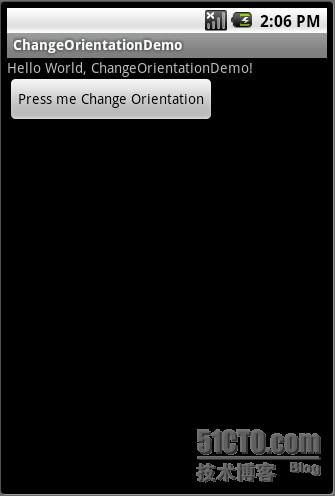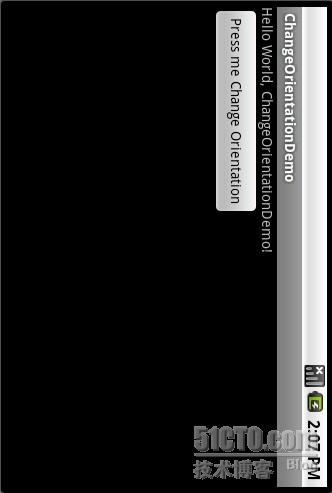大家好,今天要讲的是Android手机如何动态手机屏幕方向的,我们当中有可能手机也会有这种功能,当我们手机方向改变时, 屏幕也会跟着改变,在这Android当中是很容易实现的.本节的Demo主要是界面有一个按钮,当点击时,如果屏幕方向是横排(PORTRAIT)刚将 屏幕方向更改为竖排(LANDSCAPE),反之依然!我们这里主要是运用了getRequestedOrientation(),和 setRequestedorientation()两个方法.但是要利用这两个方法必须先在AndroidManiefst.xml设置一下屏幕方属 性,不然程序将不能正常的工作.下面我将分为N个步骤一步一步教你如何实现该Demo.
Step 1:我们建立一个Android工程,命名为ChangeOrientationDemo.
Step 2:设计UI,打开main.xml,将其代码修改如下,我们这里只是增加了一个按钮,其他什么都没有动.
 <?xml version="1.0" encoding="utf-8"?>
<?xml version="1.0" encoding="utf-8"?>  <LinearLayout xmlns:android="http://schemas.android.com/apk/res/android"
<LinearLayout xmlns:android="http://schemas.android.com/apk/res/android"  android:orientation="vertical"
android:orientation="vertical"  android:layout_width="fill_parent"
android:layout_width="fill_parent"  android:layout_height="fill_parent"
android:layout_height="fill_parent"  >
>  <TextView
<TextView  android:layout_width="fill_parent"
android:layout_width="fill_parent"  android:layout_height="wrap_content"
android:layout_height="wrap_content"  android:text="@string/hello"
android:text="@string/hello"  />
/>  <Button
<Button  android:id="@+id/bt1"
android:id="@+id/bt1"  android:layout_width="wrap_content"
android:layout_width="wrap_content"  android:layout_height="wrap_content"
android:layout_height="wrap_content"  android:text="Press me Change Orientation"
android:text="Press me Change Orientation"  />
/>  </LinearLayout>
</LinearLayout> 
 Step 3:设计主程序ChangeOrientationDemo.java,修改其代码如下:
Step 3:设计主程序ChangeOrientationDemo.java,修改其代码如下: 
 package com.android.test;
package com.android.test; 
 import android.app.Activity;
import android.app.Activity;  import android.content.pm.ActivityInfo;
import android.content.pm.ActivityInfo;  import android.os.Bundle;
import android.os.Bundle;  import android.view.View;
import android.view.View;  import android.widget.Button;
import android.widget.Button; 
 public class ChangeOrientationDemo extends Activity {
public class ChangeOrientationDemo extends Activity { 
 private Button bt1;
private Button bt1; 
 public void onCreate(Bundle savedInstanceState) {
public void onCreate(Bundle savedInstanceState) {  super.onCreate(savedInstanceState);
super.onCreate(savedInstanceState);  setContentView(R.layout.main);
setContentView(R.layout.main); 
 //获取资源
//获取资源  bt1 = (Button)findViewById(R.id.bt1);
bt1 = (Button)findViewById(R.id.bt1);  //增加按钮事件
//增加按钮事件  bt1.setOnClickListener(new Button.OnClickListener(){
bt1.setOnClickListener(new Button.OnClickListener(){ 
 @Override
@Override  public void onClick(View v) {
public void onClick(View v) {  //如果是竖排,则改为横排
//如果是竖排,则改为横排  if(getRequestedOrientation() == ActivityInfo.SCREEN_ORIENTATION_LANDSCAPE)
if(getRequestedOrientation() == ActivityInfo.SCREEN_ORIENTATION_LANDSCAPE)  {
{  setRequestedOrientation(ActivityInfo.SCREEN_ORIENTATION_PORTRAIT);
setRequestedOrientation(ActivityInfo.SCREEN_ORIENTATION_PORTRAIT);  }
} 
 //如果是横排,则改为竖排
//如果是横排,则改为竖排 
 else if(getRequestedOrientation() == ActivityInfo.SCREEN_ORIENTATION_PORTRAIT)
else if(getRequestedOrientation() == ActivityInfo.SCREEN_ORIENTATION_PORTRAIT)  {
{  setRequestedOrientation(ActivityInfo.SCREEN_ORIENTATION_LANDSCAPE);
setRequestedOrientation(ActivityInfo.SCREEN_ORIENTATION_LANDSCAPE);  }
}  }
} 
 });
});  }
} 
 }
} 
Step 4:在AndroidManifest.xml文件里设置默认方向,不然程序不能正常工作哦.代码如下:
 <?xml version="1.0" encoding="utf-8"?>
<?xml version="1.0" encoding="utf-8"?>  <manifest xmlns:android="http://schemas.android.com/apk/res/android"
<manifest xmlns:android="http://schemas.android.com/apk/res/android"  package="com.android.test"
package="com.android.test"  android:versionCode="1"
android:versionCode="1"  android:versionName="1.0">
android:versionName="1.0">  <application android:icon="@drawable/icon" android:label="@string/app_name">
<application android:icon="@drawable/icon" android:label="@string/app_name">  <activity android:name=".ChangeOrientationDemo"
<activity android:name=".ChangeOrientationDemo"  android:label="@string/app_name"
android:label="@string/app_name"  android:screenOrientation="portrait">
android:screenOrientation="portrait">  <intent-filter>
<intent-filter>  <action android:name="android.intent.action.MAIN" />
<action android:name="android.intent.action.MAIN" />  <category android:name="android.intent.category.LAUNCHER" />
<category android:name="android.intent.category.LAUNCHER" />  </intent-filter>
</intent-filter>  </activity>
</activity> 
 </application>
</application>  <uses-sdk android:minSdkVersion="3" />
<uses-sdk android:minSdkVersion="3" /> 
 </manifest>
</manifest> 
Step 5:运行程序,效果如下图:


OK,今天就到这里,谢谢大家!
本文出自 “Android_Tutor” 博客,请务必保留此出处http://weizhulin.blog.51cto.com/1556324/311469